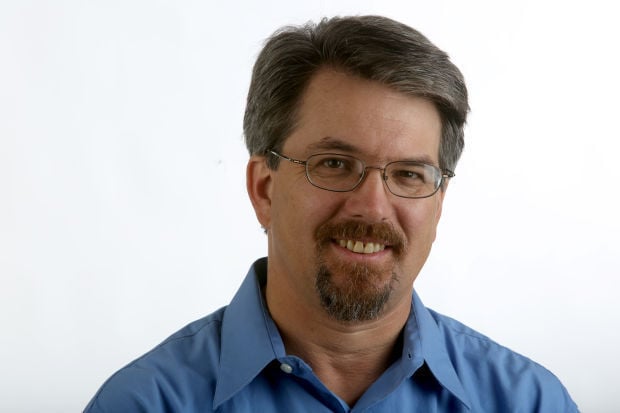On Monday, the day after the mass shooting in Orlando, I happened to see Gabrielle Giffords at a coffee shop near the university.
I exchanged greetings with Giffords and her husband, Mark Kelly, and we went about our days. No interview requests from me, no suggestions from them. I was still using my protective numbness to the latest random killings.
But in retrospect, the encounter served as a reminder. Giffords is a survivor of a mass shooting — in that way, a member of a group whose ranks are growing month after month, year after year.
Another 53 wounded survivors unwillingly joined the club on Sunday in Florida. Many will suffer physically for the rest of their lives; all will be altered.
Giffords shook my hand with her left hand because her right arm no longer works. She has trouble speaking. She survived being shot through the brain — a fact we should never grow used to. She may be the quintessential survivor of America’s mass-shooting wave, but these days, she’s just one of many.
Not only are the ranks of survivors growing, but so is the number of people who know victims of mass shootings, those of us who are just one person away from the carnage. There are the parents of the Sandy Hook, Connecticut, and Aurora, Colorado, victims. The children and grandchildren of the Charleston, South Carolina, killings. The friends and family of the Orlando victims. Many more.
Each victim and each survivor had perhaps hundreds of relationships. And each of those people experienced the attack vicariously, to greater or lesser degrees.
The result is, an increasing number of Americans don’t just respond to mass shootings as consumers of news — shocked but removed. Slowly, we are becoming a nation of mass-shooting victims and survivors.
When a mass shooting happens in Orlando, people feel it more sharply in Roseburg, Oregon, Oak Creek, Wisconsin, Fort Hood, Texas, Santa Barbara, California, Binghamton, New York, Omaha, Nebraska, and of course, here in Tucson.
The list of locations goes on. And on. And on. Look it up — you won’t believe the number of cases you’ve forgotten. Those affected are spread across the country. They also represent a demographic cross section of the United States.
With Sunday’s shooting, for example, the American subculture of gay Latinos was hit especially hard, and the impacts on that group undoubtedly rippled across the country. When the Sikh Temple in Wisconsin was attacked, Sikhs everywhere felt it. Each attack at a university tightens the chests of employees and students at colleges across the country.
It happens there is an Arizona State University mathematician who has researched the frequency of mass shootings. Research professor Sherry Towers and her colleagues gauged the “contagion effect” last year and established that after a nationally reported mass shooting, the probability of another one increases significantly over the next 13 days.
The research also helped make Towers more aware of the growing frequency and immediacy of mass killings.
“I am one degree of separation away from the Virginia Tech shooting,” Towers told me, referring to the 2007 incident in which 32 people were killed and two dozen more injured. She knows somebody who was in the building where that occurred.
“I don’t think I’m that unusual for a person in the United States,” said Towers, who is originally from Canada. “The degrees of separation become smaller and smaller.”
In Tucson, of course, we know that. I knew some of the people shot or present outside the Safeway on Jan. 8, 2011 — most closely former U.S. Rep. Ron Barber, a friend of my family. Many others did, too.
What does it mean to have so many victims, survivors and their contacts spread across the country? Some people understandably turn away from the news and numb themselves to it. But that’s too bad, because they represent a nationwide constituency now, one with potential power for good.
Pat Maisch, an Oro Valley woman who witnessed the 2011 attack here and helped subdue the shooter, became a gun-violence-prevention activist, shaming lawmakers for doing nothing in response to this random pattern of bloodshed.
“It’s always with you,” she told me Tuesday. “If you talk to other survivors, they’ll tell you the same thing. There’s no moving on. You incorporate it into your daily life.”
Kelly and Giffords started Americans for Responsible Solutions, which campaigns for more widespread background checks and other common-sense gun laws. Two days before the Orlando attack, they announced a new group supporting their effort, Veterans Coalition for Common Sense, which includes heavy hitters such as retired Coast Guard Adm. Thad Allen, Army Gen. David Petraeus and Army Gen. Stanley McChrystal, among others.
But not all efforts are aimed at changing gun laws.
The parents of Alex Teves, who was killed in the Colorado movie theater rampage, started No Notoriety, a group aimed at reducing repeated news-media use of the names and photos of killers.
The father of a young girl killed in the Sandy Hook shootings is a neuroscientist and started The Avielle Foundation to help prevent violence through neuroscience research and education.
“People try to make sense of a senseless act by doing something in their child’s or their loved-one’s honor,” Maisch said.
It’s our country’s shame that there are so many people in this position. But at this stage, their growing numbers and power may be what it takes to solve the problem.





